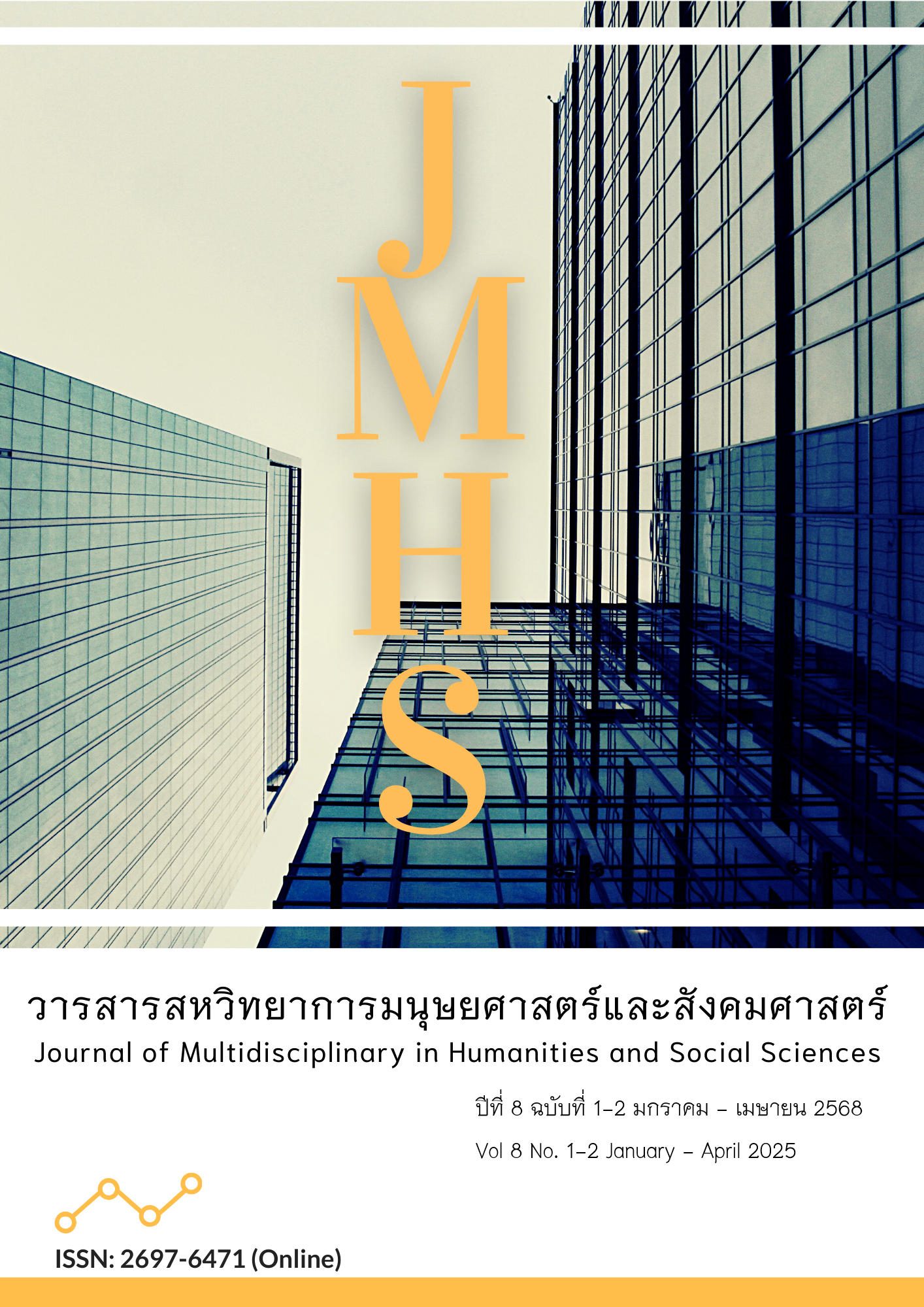The Development of White Tourism Management Model Using Information Technology in The Nong Bua Community, Chanthaburi Province
Main Article Content
Abstract
This article aims to: 1) study the impact of tourism on the way of life of people in Nong Bua Community, Chanthaburi Province, and 2) synthesize a model for white tourism management using information technology in the Nong Bua Community, Chanthaburi Province. The research model was research and development using a mixed-methods research process. It was conducted with people who have a stake in tourism within the Nong Bua Community, Chanthaburi Province, aged 20 and above, totaling 100 people, selected through purposive sampling. A questionnaire was used as a tool for data collection, and the data were analyzed using descriptive statistics combined with qualitative research methods from document analysis, related research, and interviews. The results of the data analysis are as follows: 1) The impact of tourism on the way of life of people in the Nong Bua Community, Chanthaburi Province: The attitude of most community members was uncertain about the benefits they will receive from tourism within the community, but they agreed with the benefits of tourism in terms of occupation. Economically and socially, they agreed that tourism improves the living standards of people in the community. Regarding areas that need development, most agreed with the provision of parking spaces. As for the impact of developing the community into a tourist destination, most disagreed that it negatively affects their way of life. 2) The synthesized model for white tourism management using information technology in the Nong Bua Community, Chanthaburi Province were the “BCG2DCA Model,” which consists of: 1) Bio Tourism 2) Circular Tourism 3) Green Economy 4) Data Management 5) Digital Marketing 6) Community Empowerment 7) Awareness.
Article Details

This work is licensed under a Creative Commons Attribution-NonCommercial-NoDerivatives 4.0 International License.
Views and opinions appearing in the Journal it is the responsibility of the author of the article, and does not constitute the view and responsibility of the editorial team.
References
Bairachna, K., & Krupitsa, I. (2024). Use of artificial intelligence and big data in tourist destination management. Ukraïnsʹkij žurnal prikladnoï ekonomìki, (3), 252-255. https://doi.org/ 10.36887/2415-8453-2024-3-44
Benckendorff, P., Pauline, J., Sheldon., Daniel, R., Fesenmaier. (2014). Sustainable tourism and information technology. In book: Tourism information technology (pp.308-335). https://doi.org/10.1079/9781780641850.0308
Best, J. W. (1977). Research in education. New Jersy: Prentice Hall.
Cronbach, L. J. (1951). Coefficient alpha and the internal structure of tests. Psychometrika, 16, 297–334. ttps://doi.org/10.1007/BF02310555
Dushkova, D., & Ivlieva, O. (2024). Empowering communities to act for a change: a review of the community empowerment programs towards sustainability and resilience. Sustainability, 16(19), 8700. https://doi.org/10.3390/su16198700
Faculty of Informatics. (2018). Computers and information technology in daily life. Sakaeo: Burapha University.
Gantait, A., Mathew R., Chatterjee, P., & Singh, K. (2024). Community-based tourism as a sustainable direction for the tourism industry: evidence from the Indian Sundarbans. United States: IGI Global.
Harris, J. M. (2023). Green economy. In Elgar Encyclopedia of Ecological Economics (pp. 284-288). Edward Elgar Publishing.
Hutnaleontina, P.N., Bendesa, I.K.G., & Yasa, I.G.W.M. (2022). Correlation of community-based tourism with sustainable development to improve community welfare: a review. International Journal of Applied Sciences in Tourism and Events, 6(2), 184–194. DOI:10.31940/ijaste.v6i2.183-193
Klinmuenwai, K., & Sucharitkul, J. (2022). The impact of tourism affects the local community of Khong District, Nakhon Ratchasima Province. Rajapark Journal, 16(44), 56-72. Retrieved from https://so05.tci-thaijo.org/index.php/RJPJ/article/view/255060
Likert, R. (1967). “The method of constructing and attitude scale”, In Attitude Theory and Measurement. (pp. 90-95). New York: Wiley & Son.
Mony, F., Azuz, F., Zakaria, S., Marasabessy, A., & Kaisupy, T. (2023). The impact of community-based tourism development on the socio-economic dimensions of local communities in the coastal area of Ambon Island. Technium Social Sciences Journal, 47(1), 269–278. https://doi.org/10.47577/tssj.v47i1.9465
Nassanbekova, S., & Yeshenkulova, G. (2022). Mapping analysis of the research trends on digital technologies and circular economy in tourism. Journal of Environmental Management and Tourism, 13(7), 2048-2048. https://doi.org/10.14505/jemt.v13.7(63).24
National Tourism Policy Committee. (2023). National tourism development plan 3rd (2023-2027). Bangkok: Ministry of Tourism and Sports.
Nongbua Subdistrict Municipality. (2024). Demographic information. Chanthaburi: Ministry of Interior.
Nopiyani, N.M.S., & Wirawan, I. M.A. (2021). The impact of tourism on the quality of life of communities in tourist destination areas: a systematic review. Open Access Maced J Med Sci. 19(8), 129-136. https://doi.org/10.3889/oamjms.2021.5966
Office of Community Based Tourism. (2015). Community based tourism. Bangkok: Designated Areas for Sustainable Tourism Administration (Public Organization).
Office of the National Economic and Social Development Board. (2023). The thirteenth national economic and social development plan (2023-2027). Bangkok: Office of the National Economic and Social Development Council.
Office of the Permanent Secretary. (2023). Sustainable tourism strategic plan white tourism to BCG in action (2023-2027). Bangkok: Ministry of Tourism and Sports.
Rico, S., & Peterek, M. (2024). empowering rural communities: a theoretical approach to sustainable tourism through community-based development. Technical Transactions, 121(1). https://doi.org/10.37705/TechTrans/e2024005
Safonov, Y., Kopothy, O, II., & Konarivska, O, B. (2024). Digitalisation as a marketing management tool in the tourism industry. Baltic Journal of Economic Studies, 10(3), 295-303. DOI:10.30525/2256-0742/2024-10-3-295-303
Sharafuddin, M. A., Madhavan, M., & Wangtueai, S. (2024). Assessing the effectiveness of digital marketing in enhancing tourist experiences and satisfaction: a study of Thailand’s tourism services. Administrative Sciences, 14(11), 273. https://doi.org/10.3390/admsci14110273
Singh, A., Agrawal, A., & Mishra, M., (2015). Information technology: past, present and future. Bilingual International Conference on Information Technology. (pp. 14-20). DESIDOC.
Takuli, S., Rawal, Y.S., & Takuli, S.S., (2022). A review on effect of sustainable tourism on host community. Retrieved from https://books.aijr.org/index.php/press/catalog/book/134/chapter/1753
The Government Public Relations Department. (2024). Experience the way of life community charm: strange dessert community along Nong Bua canal, Chanthaburi province. Bangkok: Office of the Prime Minister.
Vallakitkasemsakul, S. (2024). Methodology in behavioral science and social sciences. Udonthani: Uksornsilp.
Wani, Z. A., & Pant, S. (2023). Status of biodiversity in a protected area of Kashmir Himalaya: Gulmarg wildlife sanctuary. Nordic Journal of Botany, (7). https://doi.org/10.1111/njb.03982
Xiang, L. (2024). Development of digital learning platform to boost Chinese children’s mental health awareness: experts’ evaluation. International Journal of Religion, 5(10), 5448-5460. https://doi.org/10.61707/vk5s3z25

